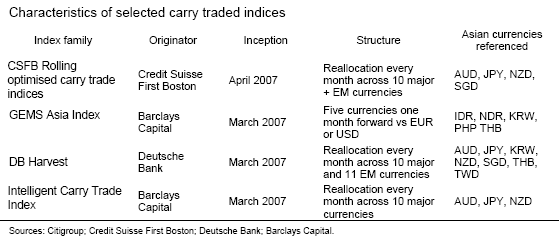Carry trades as a standard trading strategy
(Extract from pages 73-82 of BIS Quarterly Review, December 2007)
Carry trades have in recent years become so commonplace that the market has created tradable benchmarks for them and has introduced structured FX instruments referencing these indices. Several tradable carry trade index families have been launched over the last year. All of them include one or more Asian currencies (see table below). These indices combine a long position in one or more high-yielding currencies with a short position in one or more low-yielding currencies. In terms of currencies referenced, the indices fall into two categories. One category references only 10 major currencies, namely the Australian dollar (AUD), Canadian dollar (CAD), Swiss franc (CHF), euro (EUR), pound sterling (GBP), Japanese yen (JPY), Norwegian krone (NOK), New Zealand dollar (NZD), Swedish krona (SEK) and US dollar (USD). The other group references combinations of these and selected regional currencies. Thus, even the indices based on a smaller set of currencies include Asia-Pacific currencies, namely the AUD, JPY and NZD. Indices with a broader base of currencies typically include all the Asia-Pacific currencies except the CNY and HKD.
A distinction can be made between indices where the choice of funding and investment currencies is done according to simple rules and those relying on more sophisticated allocation methods. The simple rule approach, which is used by the Deutsche Bank, puts equal weight on the three lowest-yielding and the three highest-yielding currencies every month. The more sophisticated approach, which is used for the CSFB and Barclays indices, deploys some form of mean-variance optimisation when choosing the index weights, which implies lower aggregate weights on highly correlated currencies.
Recently structured FX instruments based on carry trades have also been introduced in the form of collateralised foreign exchange obligations (CFXOs). The first deals were completed in spring 2007. A CFXO is a collateralised debt obligation based on the cash flow from underlying carry trades (Merrill Lynch (2007)). Investors are paid in order of priority, starting with senior investors and ending with equity holders. An additional indication that carry trades are becoming a standard asset type in the global financial market is the fact that major international rating agencies have issued or are in the process of issuing methodology documents as well as guidelines on how they rate CFXOs and similar instruments. So far only Fitch Ratings has published guidelines and descriptions of the methodology used in their ratings (Fitch (2007)), while S&P and Moody's will probably do so going forward. Similar to carry trade indices, CFXOs typically reference either only 10 major currencies or combinations of these and other typically regional currencies.


